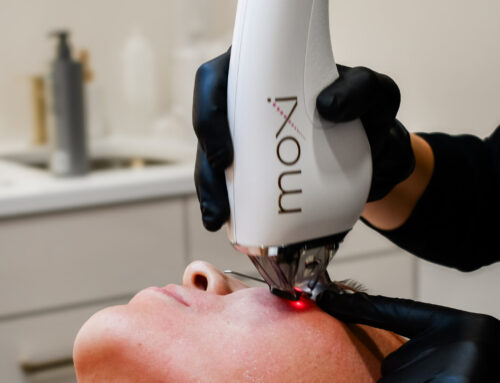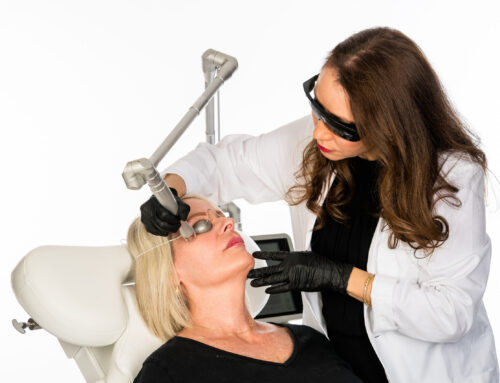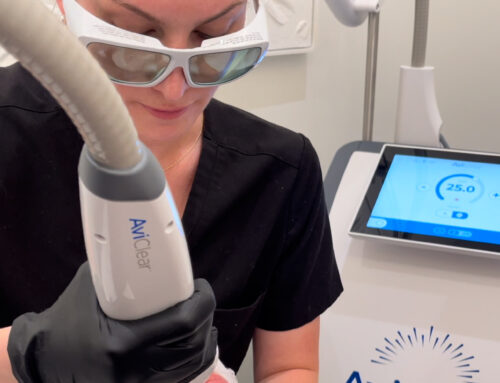By: Ashley Bond
As we eagerly approach spring, coming out of a bitter winter, our patients have a very common complaint!:
“My skin feels dry!” “My face is flaking!” “Why does my skin feel so tight?!” ”Is my skin dehydrated?”
Dry and dehydrated skin can generally feel very similar. How do we identify which category you fall under? Most importantly, HOW DO WE FIX IT?!
First, we need to break down both occurrences. By doing this we are able to understand the differences between skin types vs. skin condition. Our skin type is based on genetics, the state in which our skin presents naturally. You’re usually born with one skin type, but this can change with age and even the seasons. One way to decipher the skin type you may be categorized by how your skin responds after you wash your face. Without immediately applying a moisturizer, how does your skin respond? Do you feel dry almost instantly? Do you notice flaking skin throughout the day? Maybe even mild irritation? If so, your skin type may be dry. There are 4 different skin types we could fall under – Normal, Dry, Oily, or Combination. When your skin is considered dry, your sebaceous glands are not producing enough natural oils.
On the other hand, your skins condition is something that can be temporary and usually treatable that develops as a direct result of something, whether its hormonal changes, illnesses, medication, lifestyle changes and so on. You may experience all of the side effects of dry skin, but does it go deeper than just that? Dehydrated skin is much more common than you think. You can have whats considered a normal skin type, but show symptoms of dehydration! Dehydration is a skin condition. The definition of Dehydration is the loss or removal of water. In other words, your body is losing more water than it’s taking in or retaining. While drinking enough water plays a huge role in dehydrated skin, an increase in urination due to consuming more diuretics, such as caffeine, or even lots of sweating for strenuous exercise! Symptoms of dehydrated skin could be itchiness, dullness, darker under eye circles, sunken eyes, increased appearance of fine lines and superficial wrinkles.
How do I fix my dry skin?
Because dry skin is our skin type, or what we consider genetics, you may always feel a little more on the dry side. The best way to stay ahead of dry skin symptoms is to regularly moisturize – and that’s AM AND PM! Look for emollient creams and ingredients like glycerin and lactic acid. Monthly treatments like microdermabrasion, Dermaplane, Hydrafacial, Diamond Glow, and even light peels will help slough off dry skin and allow deeper penetration for hydrating products!
How do I fix my dehydrated skin?
Unlike dry skin, dehydration is treatable with lifestyle changes! Think working from the inside out to start! An increase in water intake and decreasing caffeine is a start – especially if you are very active! Incorporating water-rich foods in your diet like fruits and veggies (think celery, cucumbers, tomato, and watermelon). Incorporating ingredients like Hyaluronic acid, Ceramides, and Lactic Acid work wonders on dehydrated skin! Acting as humectants, these top tier compound molecules draw water into the skin helping to repair the moisture barrier and increase levels of hydration. Similarly to dry skin, exfoliation treatments will also help aide the skin get back to a hydrated state and allowing products to work their absolute best!
Often at La Chelé we recommend “boosting” your moisturizer. Due to the technology of HA5 by SkinMedica, it can act as a sponge as a base for moisturizers to be put on top of it – slow releasing all day! Our best-selling La Chelé Moisture 150 is a fabulous 24 hour release moisturizer that is a client favorite!
With warmer months just ahead, most people will notice the dry or dehydrated skin begin to dissipate. However, if you’re someone who struggling to get their skin feelings its absolute best, try these tips and don’t forget the SPF!






